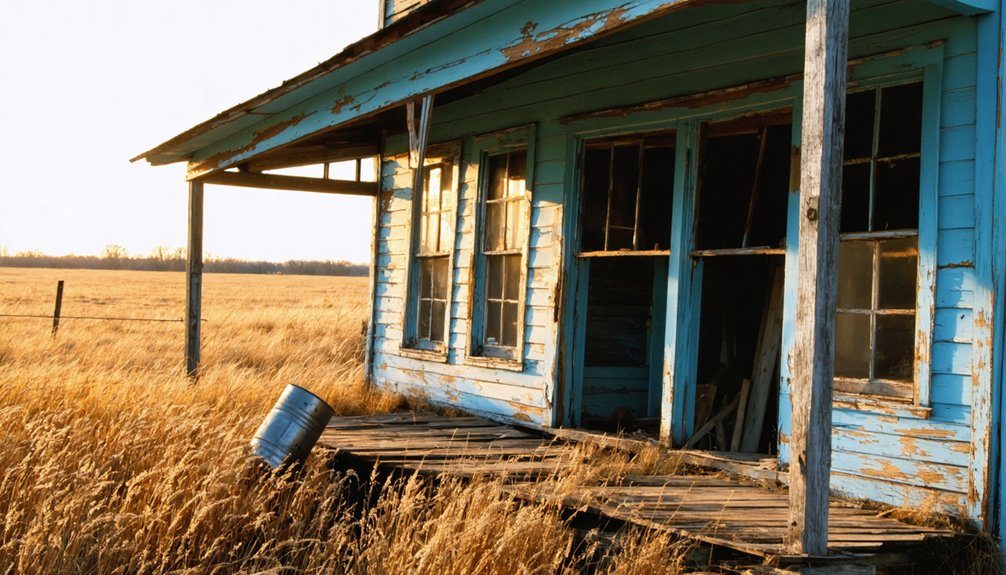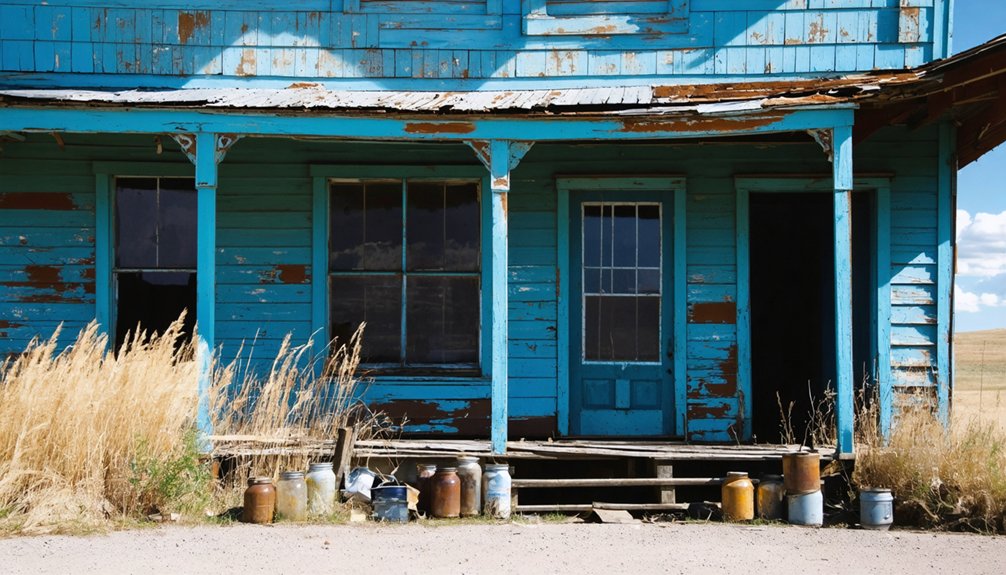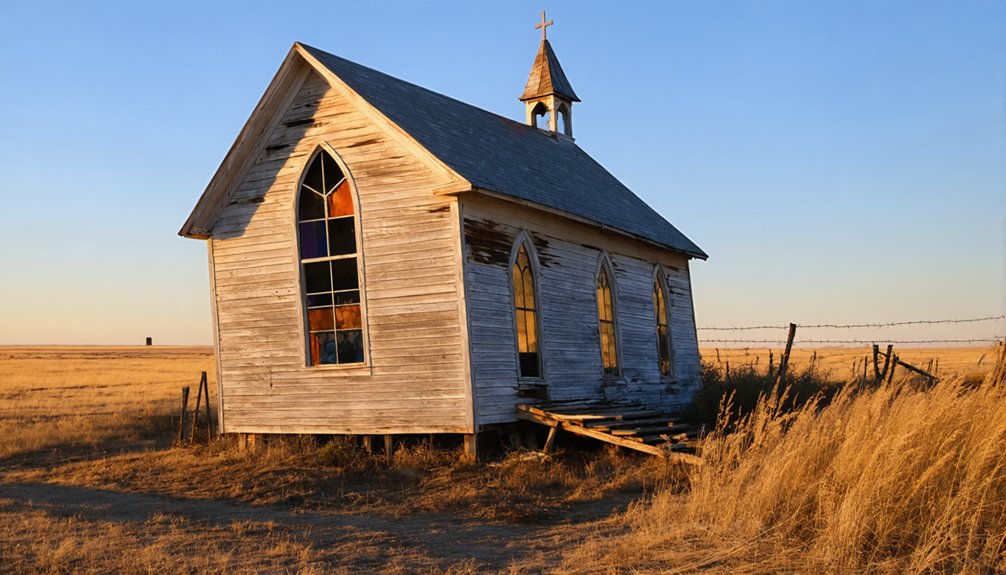You’ll find Edgerton’s ghost town remains about eight miles north of Colorado Springs, where Monument Creek meets West Monument Creek. Once a thriving coal mining community established in 1881, it collapsed by 1905 when coal deposits dwindled. Today, hike the Santa Fe Regional Trail to discover stone foundations of the Edgerton Hotel, stage station, and scattered mining infrastructure. Nature has reclaimed most structures, but winter reveals hidden ruins beneath seasonal vegetation.
Key Takeaways
- Edgerton was a bustling coal mining boomtown in Colorado that declined in the early 1900s after coal deposits were depleted.
- Located eight miles north of Colorado Springs, the ghost town sits at the confluence of Monument Creek and West Monument Creek.
- Remnants include foundations of the Edgerton Hotel, stage station, and company housing now partially submerged by Edgerton Reservoir.
- The town’s economic collapse was marked by the railroad post office closure in 1902 and school closure in 1915.
- Visitors can access the site via the Santa Fe Regional Trail, where nature has reclaimed many historical structures.
The Rise of a Coal Mining Boomtown (1881)
When coal was discovered in the Rockvale area near present-day Edgerton in 1859, few could have imagined the bustling boomtown that would emerge just two decades later.
The coal discovery reached its pinnacle in August 1881 when miners struck a rich seam at Rockvale No. 1, measuring over three feet thick at 325 feet below ground.
This discovery came during Colorado’s broader mineral boom, which had already attracted thousands of Fifty-Niners seeking fortune in the territory’s gold-rich streams and mountains.
Many of the workers were European immigrants who traveled far from their homelands seeking employment in Colorado’s expanding coal industry.
Life in Edgerton’s Mining Community
The hardscrabble life of Edgerton’s mining community embodied the spirit of Colorado’s industrial frontier, where coal dust and community bonds formed the fabric of daily existence.
You’d find your life revolving around the mine’s schedule, with men descending daily into the earth facing mining hazards like cave-ins and toxic gases. The rough justice common in these settlements meant that vigilante action often substituted for formal law enforcement.
Your family would’ve lived in company-built housing, with women maintaining homes while children attended the local school. The path to work often meant crossing rocky creek beds that transformed with each season. Water from the town’s reservoir and filtration house sustained daily needs.
After grueling shifts, community gatherings at churches provided rare respite from isolation and danger.
When the whistle blew, you’d join neighbors for social events that strengthened your collective resilience. This interdependence defined Edgerton until 1905, when depleted coal reserves forced residents to abandon the town they’d called home.
The Spanish Peaks Region: Natural Setting
Standing prominently on the western horizon of Edgerton’s landscape, the Spanish Peaks—locally known as “Wahatoya” or “breasts of the earth”—rise dramatically with their igneous summits towering over 13,000 feet above sea level.
You’ll notice these majestic landmarks formed not through crustal thrusting but by massive igneous intrusions some 24-27 million years ago, creating the distinctive radial dike systems that fan out like spokes from the peaks. Recent research published in “Lithosphere” reveals that rapid erosion rates removed nearly a kilometer of sedimentary material within just 1 million years, gradually exposing these volcanic formations.
The mountains are geological stocks—large masses of igneous rock that cooled and solidified beneath the Earth’s surface before being exposed through years of erosion.
Within this diverse ecological setting, Edgerton’s residents enjoyed habitats ranging from alpine tundra to piñon-juniper woodlands, supporting wildlife that thrived across the region’s varied elevations and microclimates.
Majestic Mountain Backdrop
Rising majestically against Colorado’s vast sky, the Spanish Peaks dominate Edgerton’s natural landscape, serving as both sentinel and backdrop to the ghost town‘s remnants.
These striking mountain vistas weren’t formed by crustal movement but through volcanic activity 24-27 million years ago when magma intruded sedimentary layers.
As you explore Edgerton, you’ll witness geological wonders that tell Earth’s dramatic story. West Spanish Peak towers at 13,623 feet while its eastern counterpart reaches 12,708 feet—both exposed through extraordinary erosion that stripped away over 1,500 meters of rock.
The peaks’ famous radial dike systems, among the world’s most well-developed, stretch up to 12.5 miles across the landscape. Indigenous Comanche people recognized their significance, calling them “Wahatoya” or “Double Mountain.” These volcanic remnants stand as evidence to the powerful forces that shaped this region where the Great Plains meet the Sangre de Cristo foothills. Located in south-central Colorado, the Spanish Peaks sit at the western edge of the Great Plains physiographic region, creating a breathtaking transition between the plains and mountains.
Rich Ecological Diversity
Beyond the dramatic geological formations of the Spanish Peaks lies a remarkably diverse ecological tapestry that blankets Edgerton’s surrounding landscape.
You’ll discover ponderosa pine dominating north-facing slopes, while drought-resistant juniper, Gambel oak, and mountain mahogany thrive on sunnier west and southeast aspects.
The area represents one of Colorado’s biodiversity hotspots, supporting 86 mammal species, 259 bird types, and dozens of reptiles and amphibians.
As you explore, you might spot deer, elk, or wild turkey utilizing the varied terrain. Recent ecological restoration through forest thinning has enhanced wildlife movement corridors and improved habitat quality. The local ecosystem now benefits from proactive management projects that have treated approximately 370 acres to increase sunlight penetration and understory growth.
The Cucharas River’s riparian zones serve as ecological highways, connecting diverse microclimates created by the region’s unique topography and geology—from the 7,000-foot plains to the 13,000-foot peaks.
Economic Collapse and the End of an Era
As the coal deposits that had sustained Edgerton began to dwindle in the early 1900s, the town’s fate was sealed in a pattern all too familiar in mining communities across Colorado.
By 1905, the mines were exhausted, triggering a swift economic collapse that exposed the dangers of poor resource management and lack of economic resilience. This situation reflects the common necessity for disambiguation of places that share similar histories but different geographical locations.
The rapid death of Edgerton’s economy reveals the perilous fragility of single-industry towns built on finite resources.
The town’s decline accelerated through a series of essential losses:
- The railroad post office closed in 1902, moving to Pikeview and severing crucial communication links.
- Edgerton School shuttered in 1915, reflecting the exodus of families seeking opportunity elsewhere.
- The town’s hotel—once a thriving social center—stood empty before eventually being dismantled.
Without coal or alternative industries, Edgerton’s transformation into a ghost town was inevitable.
What Remains: Exploring Edgerton’s Ruins

As you walk through the meadow at the confluence of Monument Creek and West Monument Creek, you’ll find only stone foundations of the once-bustling Edgerton Hotel and adjacent stables scattered across the landscape.
Nature has steadily reclaimed most of the thick-walled structures that once protected settlers from raids, with the ruins now blending into the Santa Fe Regional Trail area.
The remaining stonework, with its occasional narrow rifle slots, offers a tangible connection to the stagecoach era when this strategic location served as both a crucial rest stop and defensive position for travelers between Colorado Springs and Denver.
Scattered Mining Foundations
While modern visitors explore Edgerton today, they’ll discover only scattered remnants of its once-thriving mining community scattered throughout the landscape.
These historical remnants tell a silent story of industrial ambition now reclaimed by nature. The mining infrastructure that once dominated this coal town has largely disappeared, with only rough-hewn stone foundations and weathered wooden supports marking where buildings once stood.
As you wander through the site, you’ll find:
- Partially visible foundations of company housing and essential buildings like the general store and school
- Creek-side remnants including pipes and water management systems that served the mines
- Traces of industrial structures nestled among trees that have grown through decades of abandonment
No official archaeological survey exists, making each discovery a personal connection to Colorado’s mining heritage.
Nature Reclaims History
Today’s visitor to Edgerton will find nature steadily reclaiming what humans once built with such determination. Thick stone walls with narrow rifle slots—testament to frontier tensions—now crumble beneath invading grasses and wildflowers.
You’ll spot foundations of the once-prominent Edgerton Hotel along the Santa Fe Regional Trail, though most structures have surrendered to Colorado’s harsh elements.
Winter offers the best viewing opportunity as seasonal vegetation retreats, revealing ruins otherwise hidden by summer’s growth. The old stagecoach route and Camp Creek remnants provide glimpses into Edgerton’s transportation significance, though flooding and erosion continuously reshape these historical markers.
This delicate balance between nature’s reclamation and historical preservation tells a powerful story of frontier life, allowing you to witness firsthand how quickly our built environment returns to wilderness when left untended.
Reservoir’s Final Traces
The placid waters of Edgerton Reservoir now mask many secrets of the once-thriving settlement at the confluence of Monument Creek and West Monument Creek.
Despite the reservoir’s transformation of this landscape, determined explorers can still discover fragments of Edgerton’s past scattered around the water’s edge.
As you explore the area, you’ll find:
- Stone foundations of the Edgerton Hotel and stables in the nearby meadow
- Remnants of the stage station and stone barn where travelers once rested
- Old pipe sections and building materials near creek crossings
The delicate balance between reservoir ecology and historical preservation continues to shape Edgerton’s legacy.
Winter visits often reveal more ruins as vegetation recedes, offering a deeper connection to this forgotten community eight miles north of Colorado Springs.
The 2022 Reservoir Deconstruction

Despite extensive research into Colorado’s water infrastructure projects between 2022-2025, no credible evidence exists of a reservoir deconstruction in Edgerton during this period.
This finding contradicts several reservoir deconstruction myths that have circulated among history enthusiasts and tourists visiting the area.
While many Colorado reservoirs underwent expansion or construction during this timeframe—like Gross Reservoir and Chimney Hollow—Edgerton wasn’t among locations with documented dismantling activities.
No NEPA reviews, environmental impact statements, or permitting processes were initiated, all of which would be mandatory for such a project.
Community impact misconceptions about water supply disruptions or property value changes haven’t materialized because no such project occurred.
The absence in federal databases, local reporting, and state water board records confirms that Edgerton’s ghost town status wasn’t affected by reservoir removal during this period.
Finding Edgerton: Visitor Information
While researching Edgerton’s non-existent reservoir project, many visitors wonder about actually locating this elusive ghost town.
You’ll find this historically significant site at the confluence of Monument Creek and West Monument Creek (38°57′38″N, 104°50′09″W), about eight miles north of Colorado Springs. Access requires hiking via the Santa Fe Regional Trail through meadows where the old Camp Creek Road once ran.
For your Edgerton exploration tips:
- Bring water and comfortable shoes—there are no facilities or amenities at this undeveloped archaeological site
- Look for stone foundations of the former two-story hotel, stage station, and barn—all that remains today
- Respect the historical remains by taking only photographs and leaving no trace
Photographic Journey Through Colorado’s Lost Town

As photographs of Edgerton today reveal, this forgotten coal mining community remains frozen in time, offering visitors a haunting glimpse into Colorado’s industrial past.
Through the lens, you’ll discover the filtration house ruins and remnants of the coal breaker where miners once processed the very resource that sustained their community dynamics.
The underwater and terrestrial photography captures foundations of homes where families lived alongside churches and schools that served this purpose-built town.
Unlike other ghost towns that suffer from vandalism, Edgerton’s pristine condition allows you to visualize the mining techniques that drove its 24-year existence.
Nature now reclaims the landscape around Edgerton Reservoir, creating a striking contrast between industrial history and serene wilderness—a visual reflection of Colorado’s boom-and-bust mining legacy.
Frequently Asked Questions
Were Any Famous People Born in or Associated With Edgerton?
No, you won’t find any famous residents or historical figures connected to Edgerton. The town’s brief existence as a mining community didn’t produce nationally recognized individuals before its abandonment in 1905.
What Happened to the Mining Equipment After the Town Was Abandoned?
Like vanishing ghosts of a faded mining legacy, you’d find most equipment was removed, sold off, or salvaged. Whatever remained weathered away with time, leaving no meaningful preservation of Edgerton’s industrial history.
Are There Any Dangerous Conditions Visitors Should Be Aware Of?
You’ll face serious dangers including unstable structures that could collapse without warning, wildlife hazards from bears to rattlesnakes, and potentially hazardous remnants of mining operations throughout the abandoned site.
Were There Any Significant Historical Events or Disasters in Edgerton?
Unlike today’s social media sensations, Edgerton’s history was remarkably disaster-free. You won’t find dramatic calamities here—the town decline came simply from coal depletion in 1905, making it a peaceful historical footnote.
Is Metal Detecting or Artifact Collection Allowed at the Site?
No, you’re not allowed to metal detect at this site. Federal laws strictly protect historic artifacts, and metal detecting laws require permits for archaeological areas, supporting community-based artifact preservation instead of individual collection.
References
- https://www.gutenberg.org/files/51678/51678-h/51678-h.htm
- https://www.youtube.com/watch?v=fsFd0XElKSo
- https://en.wikipedia.org/wiki/List_of_ghost_towns_in_Colorado
- https://www.uncovercolorado.com/ghost-towns/
- https://www.coloradolifemagazine.com/printpage/post/index/id/172
- https://www.colorado.com/articles/colorado-ghost-towns
- http://www.miningartifacts.org/Colorado-Mines.html
- https://royalgorgeregion.com/wp-content/uploads/Coal-Camps-Online.pdf
- https://www.unco.edu/hewit/doing-history/colorado-miners/work-tools/coal.aspx
- https://en.wikipedia.org/wiki/Timeline_of_mining_in_Colorado



